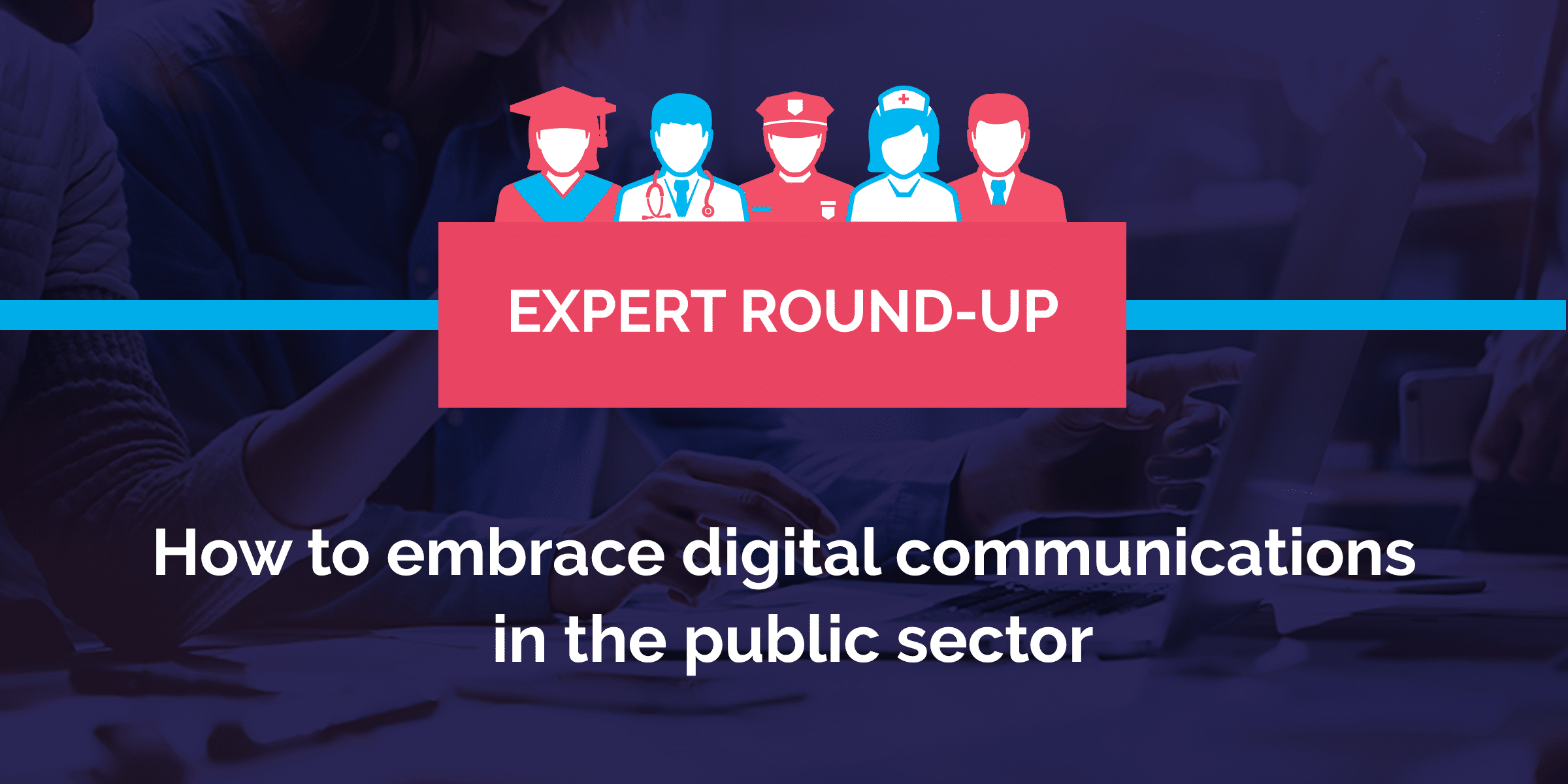
Digital transformation is happening to all of us now and there’ll be no going back. Our lives are changing and changing fast and so are the ways we communicate with each other.
This means that old ways of engaging with the public are becoming increasingly out-of-date. But is the public sector able to adapt, and more importantly is it willing to?
That’s the biggest challenge facing your workplace today.
Facing the challenge of digital transformation
Being ready to face it means knowing how to take full advantage of digital transformation practices already starting taking place.
So if you’re looking for inspiration, then where better to get it than from some of your peers who are leading the way.
You’ll be hearing from these trailblazers across a series of blogs.
Learning from your peers
And to start us off, here are our the first 10 who talk about how they’ve adopted digital transformation techniques across all sorts of online touchpoints from using Facebook and Twitter to fight crime in the UK, to providing relevant personalised content for the citizens of and visitors to Limerick City.

Aidan McGrath
Head of Recruitment, Beaumont Hospital
As public service leaders, it’s our responsibility to ensure our public services are staffed with the highest quality candidates. A recent study by Jobvite stated that 59% of recruiters rated social media sourced candidates as ‘highest quality’. With this in mind, it’s imperative that public service organisations, whether large or small, harness and engage social media as part of their hiring process.
59% of recruiters rated social media sourced candidates as ‘highest quality’. With this in mind, it’s imperative that public service organisations, whether large or small, harness and engage social media as part of their hiring process.Click To Tweet
Cliona Connolly
Irish Press Officer, EPP Group, EU Parliament
The Public Sector has a responsibility to inform the public, whether that's as a legal obligation or as a moral duty to its citizens.
Social media provides an array of innovative tools that reach a diverse range of people who may not otherwise hear or see our messages in traditional media.
Then understanding your goals, identifying any interesting or valuable information you have and being creative in how you deliver it is key.
You should also ensure you put the 'social' in social media by engaging in two-way conversations, so you can build trust and create a loyal following.
In short, you should always provide added value for our followers.
Social media provides an array of innovative tools that reach a diverse range of people who may not otherwise hear or see our messages in traditional media.Click To Tweet
Kieran Comerford
Head of Enterprise at Local Enterprise Office - Carlow County Council
In our organisation we use digital communications to effectively support our enterprise eco-system
We invest in content designed to engage the user, to provide them with expert advice (from internal and external sources) and to bring them along the customer support journey created by our Local Enterprise Office.
We do this by using online videos, managed social posts, virtual networks, and by using platforms such as LinkedIn to highlight all the benefits that working with our Carlow office can bring.
From organising local events to networking internationally, digital has helped us increase our audience and effectively target our marketing efforts.
We use digital comms to effectively support our enterprise eco-system by investing in content designed to engage the user, providing them with expert advice and bringing them along the support journey created by our Local Enterprise Office.Click To Tweet
Tom Banville
CEO, Wexford LEO
Most of our communications here at LEO Wexford simply need to be digital for two reasons:
Firstly, entrepreneurs like to conduct research online as they build their enterprise. So through our website, active social media accounts and weekly digital newsletter, we’ve got helpful content in place where the public can easily find it.
Secondly, there are so many great courses, networking events and funding opportunities where we can deliver relevant information to people via an immediate call to action (such as following a link to book a course via our website). This makes our communications much more effective.
Entrepreneurs like to conduct research online as they build their enterprise. So, through our website, active social media accounts and weekly digital newsletter, we’ve got helpful content in place where the public can easily find it.Click To Tweet
Laura Ryan
Head of Marketing and Communications, Limerick City and County Council
Limerick.ie is a leader in digital communications for local government in Ireland. Why? Because it has been designed around its users in the community. Each of them has their own private login where they can create an individualised profile of interests, build itineraries on what to see and do in Limerick, and see all their dealings with the Council.
The aim of the site is to always present Limerick in a positive light, to give information about Limerick City and County Council services and be number one in searches for information on Limerick. We publish relevant and up-to-date content by working with partners in the region and in showcasing Limerick’s unique selling points by providing information on visiting, investing, learning, living and events in Limerick.
We’re now setting the foundation for what people can do with the platform and what it can do for them. And we’re developing these personalised services in an integrated way, so we can develop this experience for years to come.
Limerick.ie has been designed around its users in the community. Each of them has their own private login where they can create an individualised profile of interests, build itineraries, and see all their dealings with the Council.Click To Tweet
Glenn Hurst
Lecturer (Assistant Professor) at the Department of Chemistry in the University of York, UK
Advances in digital communications are transforming the way in which students are able to learn at all levels of study. Social media platforms such as Facebook, Instagram, Snapchat, Twitter and YouTube have been utilised as a vehicle to significantly enhance the communication skills of learners together by providing a space to form an online community
Further to being able to utilise social media to enhance engagement of learners with subject matter, social media is also an effective tool for instructors to be able to provide additional feedback to students in a quick and easy manner. In short, use of social media as a learning aid is here to stay.
Advances in digital communications are transforming the way in which students are able to learn. Social media platforms have been utilised to significantly enhance the communication skills of learners together.Click To Tweet
Sinead Coyne
Head of Communications, Seafest / Marine Institute
Communicating with members of the public has never been easier as we can have both one-to-one and wider conversations. However, the demands on our time and the need to upskill are key considerations in our digital transformation process.
We’ve a dedicated social media manager at the Marine Institute whom we’ve empowered to be our public-facing voice. Our traditional communications methods are amplified through our website and range of digital platforms.
We’re encouraging everyone in our organisation to have a digital-first mindset but we recognise full digital transformation takes time, and requires a fully worked out strategy.
It’s a remarkable time to be able to provide such personalised communications, which are distributed to our many stakeholders across the globe, and who have broad and varied needs.
We’ve a dedicated social media manager at the Marine Institute whom we’ve empowered to be our public-facing voice. Our traditional communications methods are amplified through our website and range of digital platforms.Click To Tweet
David Bailey
Lead at the The Digital Policing Portfolio (DPP) in the UK and Senior Communications Manager at Staffordshire Police
Blogger at: www.policemediablog.com
Social media has massively aided policing. The public now expect to be able to ask the police a question and get an answer, and trust that answer. And they want to be able to have those conversations with us on the channels that they want to choose.
Facebook means we can drive conversations locally and help us find missing people, identify offenders or educate around when you might need to take action or stay safe.
Whereas Twitter works really well in getting updates or alerts out fast.
And by 2025 digital policing will make it easier and more consistent for the public to make digital contact, improve our use of digital intelligence and evidence, and ensure we can transfer all material in a digital format to the criminal justice system.
Social media has massively aided policing. The public now expect to be able to ask the police a question and get an answer, and trust that answer. And they want to be able to have those conversations with us on the channels that they want to choose.Click To Tweet
Ronan Doyle
Communications Manager, Grangegorman Development Agency (GDA)
Over the past 10 years social media has become an essential tool for getting a variety of communications to our audience.
Facebook in particular is the platform which has become our top channel as our audience demographic tends to favour it.
We’ve found that by interspersing important day-to day-information with more interesting historical and topical stories we can grow our audience and keep them both engaged and informed.
Having our Facebook and Twitter accounts linked ensures we keep a regular feed to Twitter, and that encourages more interactions to a growing audience.
We’ve found that by interspersing important day-to day-information with more interesting stories we can grow our audience and keep them engaged.Click To Tweet
Jane Ryder
Communications Manager, Food Safety Authority of Ireland
Having a presence on Twitter, Facebook and LinkedIn is essential for us as the food regulator.
It enables us to reach a wider audience, to be proactive, to improve our customer service, to create awareness about our food industry events, to build a greater online profile, to build a community around food safety, to generate traffic to our website, and to interact directly with our stakeholders.
It’s also proven essential if there’s an issue with a food where we need to get key messages out there quickly to consumers and the food industry. Social media is integrated into our communications strategy and is at the heart of our engagement with our stakeholders.
Having a presence on Twitter, Facebook and LinkedIn is essential for us as the food regulator for many important reasons. It’s now integrated into our communications strategy and is at the heart of our engagement with our stakeholders.Click To Tweet
We hope you were inspired
These are just 10 of your peers who are implementing game-changing digital media strategies every day for their organisations.
So isn’t time you got on board too?
Making this transformation can be daunting, but it’s also exciting to see just what can be achieved with all these innovations.
Transformation across so many areas
Just look at all the different benefits the Food Safety Authority, the Local Enterprise Office in Carlow to the Department of Chemistry
They are using social media and other online touchpoint in many different ways, with many different audiences but yet it’s transforming the way they operate, as well as communicate.
It’s over to you
And by helping to lead the adoption of digital transformation techniques where you work, you’ll be at the forefront of transforming society for the better of everyone too.
Until next time,
Like, post and share!
Joanne

 JOIN OUR FACEBOOK GROUP
JOIN OUR FACEBOOK GROUP
Leave a Reply